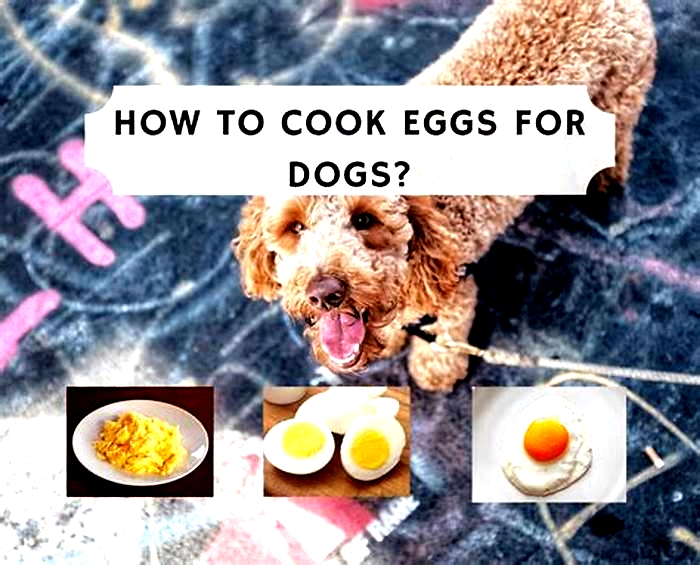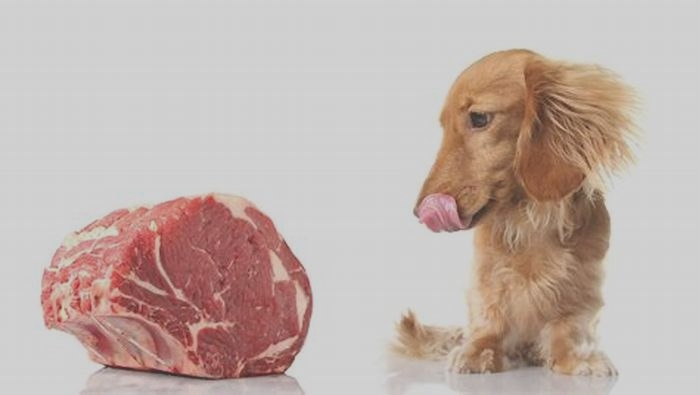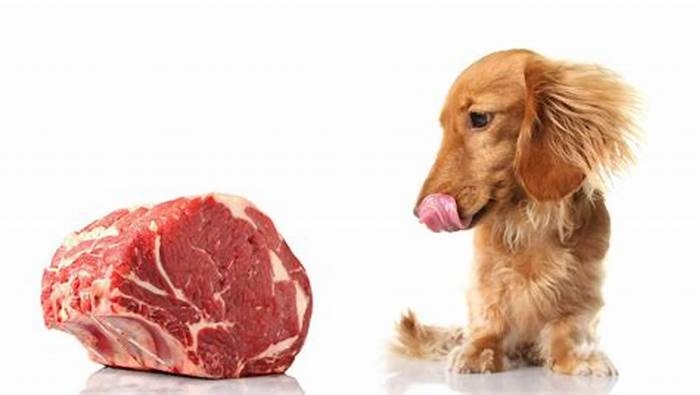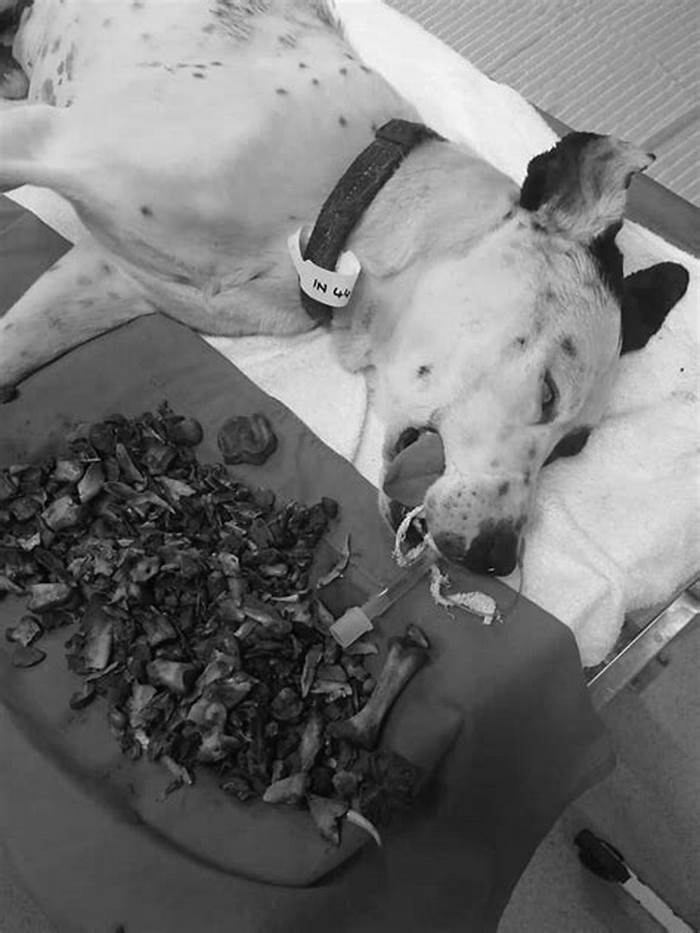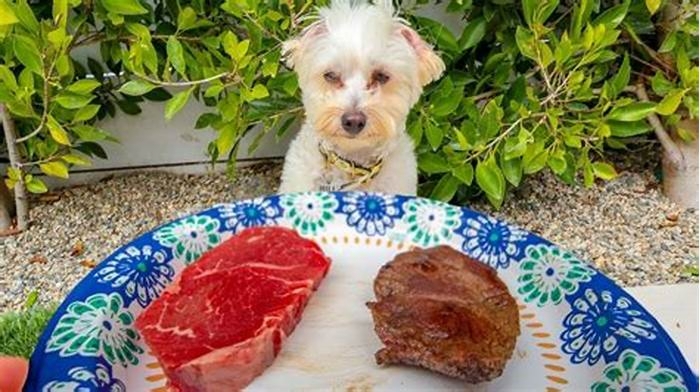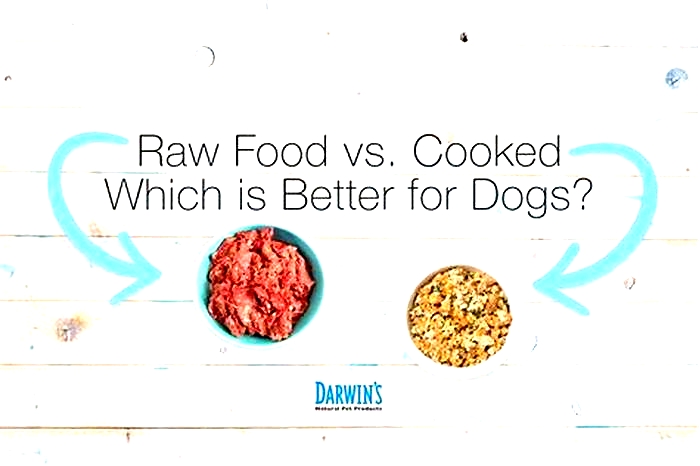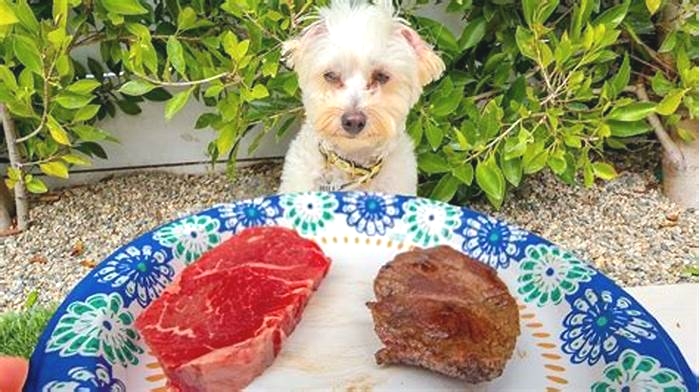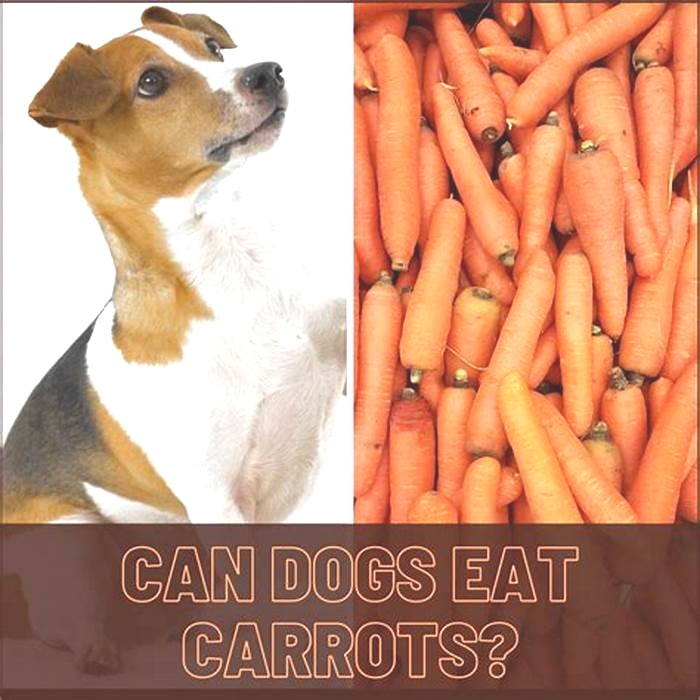Is it better to give dogs raw or cooked meat

Should Your Dog's Food Be Raw or Cooked? Pros and Cons
Most people who feed real food to their dogs cook the food. And that's fine much, much better than feeding kibble or canned.
But an increasing number of owners, breeders, trainers, even veterinarians, have gone back to the traditional practice of feeding raw food to their dogs.
Dogs have been fed raw food (meat, fish, eggs) for more than fifteen thousand years.
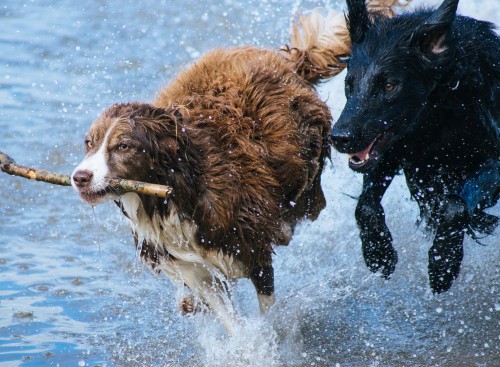
It's only comparatively recently that people began offering cooked food. A dog's digestive system isn't really designed for digesting cooked food, but it can usually adapt to simple cooked foods like meat, fish, eggs, and veggies.
At least.... many dogs can.
So if you've decided you want to try feeding real food, your first decision should be: raw or cooked?
| Raw | Cooked | |
|---|---|---|
| Digestibility | dogs absorb raw nutrients to the max | cooked nutrients are not as well-absorbed |
| "Exercises" your dog's digestive system | yes | not very much |
| Amount of poop | less | more |
| Includes vitamins, antioxidants, amino acids, enzymes | lots | many are killed or damaged by cooking |
| Risk of bacteria in the food | small amount is sometimes present | most are killed by cooking |
As you can see, raw wins on all counts except for the risk of bacteria.
Let's talk first about all those green checkmarks where raw is superior to cooked.
Then I'll answer the controversial question, "Is raw food safe to feed a dog?"
5 reasons raw food is better than cooked food
Reason #1: Dogs are designed to eat raw food, to completely digest raw food, and to draw the maximum nutrients from raw food.
Every part of your dog's digestive tract is tailor-made for raw food. The shape of his teeth are perfect for tearing meat. The strength of his jaws crushes small bones. The powerful hydrochloric acid in his stomach breaks down tough food material and kills bacteria. His short, straight intestinal tract quickly eliminates any questionable food before it can do any harm.
That's the digestive system of a raw meat eater. That's the digestive system of your dog, whether Chihuahua or a Great Dane.
The entire canine family (wolves, coyotes, wild dogs, domesticated dogs) has a digestive system designed to eat, digest, and absorb raw meat.
Which makes sense, because they can't roast or bake the rabbits they catch, right? They just eat the thing raw.
That's why a raw diet is also called a biologically-appropriate or species-appropriate diet.
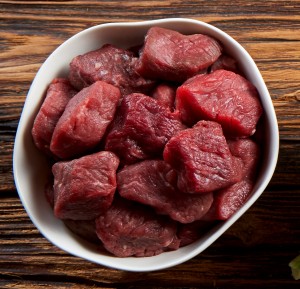
Reason #2: Eating raw food keeps a dog's digestive system fit and healthy.
You know the old expression, "Use it or lose it"? When a dog's digestive system goes to work digesting raw food, his digestive system is being exercised, which helps it stay strong and healthy.
Unfortunately, cooked meat makes your dog's digestive system lazy. When you cook meat, the heat breaks down the meat so that what you serve to the dog is already semi-digested. Eating semi-digested meat doesn't exercise his digestive system, and this lack of use can open the door to future digestive ailments.
Reason #3: Raw food is packed with enzymes, vitamins, amino acids, and antioxidants.
Sadly, these vital nutrients are damaged by cooking. In the case of essential digestive enzymes, now your dog must produce those missing enzymes in his pancreas. Forcing the pancreas to work overtime when it shouldn't need to, can lead to pancreatic ailments.
When you cook your dog's food, or whenever you feed kibble or canned food (which are always cooked), you should ADD synthetic digestive enzymes to the food to help him digest it. Prozyme, Naturvet, and Dr. Goodpet are popular brands.
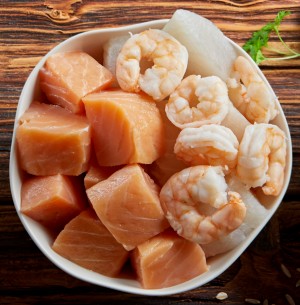
Reason #4: Raw foods contain a unique form of moisture that cooked foods don't have.
We all know that meat and veggies are naturally wet. Touch meat and you can feel its juices. Peel a carrot and the inside looks and feels moist and juicy.
But here I'm not talking about the kind of moisture that you can see or feel.
There's a more important kind of moisture that raw foods have. It's an internal moisture packed inside the molecular cells of raw meat, vegetables, and fruits.
Internal moisture is only released after the food reaches the intestines. This liquid bathes the intestines to keep them moist and slippery, which helps avoid constipation.
Unfortunately, although cooked meat and veggies look and feel moist, their molecular cells have been broken down by the heat, and their valuable internal moisture has been lost.
Reason #5: Dogs are less commonly allergic to raw food, and more often allergic to cooked food.
For example, Cashew is a Cocker Spaniel owned by a friend of mine. Cashew is allergic to cooked beef, and also to kibble and canned foods that contain beef. (All kibble and canned foods are cooked).
But when switched to raw beef, Cashew had no problems. This is probably because the proteins in raw beef are in their natural form and thus recognizable by the dog's digestive system.
Whereas cooking alters the molecular shape of meat proteins so much that the digestive tract doesn't even recognize it as food. Then the dog's immune system says, "Hey, what's that?" and sends out waves of histamines to attack the unrecognized "intruder". The result can be chronic allergies or digestive upsets.
Related:5 Best Raw Dog Foods (Frozen & Freeze-Dried)
Is raw food safe?
Whenever the topic of raw food comes up, especially raw meat, the #1 concern that dog owners have is, "Isn't that risky?"
Our mothers and grandmothers have taught us to be careful around raw meat. We wash our hands thoroughly after handling it. We sterilize our countertops.
So how could raw meat be safe for dogs? Doesn't it have bacteria in it? Like e.coli or salmonella?
Yes, pathogens can be present in raw meat.
Pathogens can exist on raw veggies and fruits, too. There have been many supermarket recalls of veggies and fruits for bacterial contamination.
Even dry and canned dog foods (which are all cooked) have been recalled for contamination from pathogens.
Unless we keep our dogs in a bubble, we cannot keep them away from pathogens. Bacteria is everywhere. That's the bad news.
The good news is that a small number of bacteria doesn't bother a healthy dog with a normal immune system. It's gross to think about, but doesn't your dog lick his own behind? Lots of e.coli in poop, but he doesn't get sick from that. Bacteria only become dangerous when they're able to colonize and multiply, and that rarely happens in a healthy dog.
Remember when I said that the canine family has a digestive system designed for raw food? Let's look at how that works:
- A dog's stomach produces powerful hydrochloric acid. Bacteria die off in acidic environments.
- A dog's digestive tract is short, which means waste material zips through quickly. Any bacteria that may have escaped the strong stomach acid doesn't have much time to dig in and multiply before getting pooped out.
In other words, strong stomach acids + quick elimination = little chance of normal bacteria causing any problems for a normal dog.
Ah-ha! Notice that I said "little chance of normal bacteria causing any problems for a normal dog."
You might have some questions about that word normal. For example, "If you buy raw meat at the supermarket and it happens to contain bacteria, how do you know it's normal bacteria?
What if it's LOTS of bacteria? Or some superform of bacteria?
You've probably seen ugly documentaries about the sorry state of our slaughterhouses and meat processing plants. They're awful.
Could the raw meat you buy at the supermarket be so contaminated that it's too much for even a DOG'S strong digestive system to handle?

That's a fair question. I have the same concern.
So I don't feed raw meat from the supermarket. I feed organic, grass-fed meat from my local farmer's market. The livestock is raised on small farms, grass-fed, without hormones or antibiotics, and without being processed through the giant processing plants that supply supermarkets with their meat. I can't prove that my meat is safer, but it feels safer.
I also rotate my homemade raw diet with a commercial raw diet that has been subjected to a safety process that kills bacteria. It's called High Pressure Pasteurization and it means the food was treated with extremely high water pressure that kills bad buggers like e.coli, salmonella, and listeria. One company describes it as "putting the squeeze" on pathogens without destroying vital nutrients as would occur with heating.
Next question..... just as we might ask what "normal" bacteria is, we might ask what a "normal" dog is.
Obviously our dogs aren't wolves and they're not wild. Is the digestive system of a domesticated dog still able to handle raw?
Yes. All over the world, thousands upon thousands of owners, breeders, trainers, and veterinarians feed raw. They feed raw to puppies and adult dogs, to mixed breeds, crossbreeds, and purebreds, from Chihuahuas to Great Danes.
The digestive system of a domestic dog is not appreciably different from that of a wild dog.
However....
The longer your particular dog has been eating cooked food (or dry kibble or canned food, which are also cooked), the more slowly you should transition him to raw.
This is because his digestive system has become lazier and less functional from the unnatural diet. It needs a few weeks to build up the proper enzymes for a natural diet
What if a dog is unhealthy? Suppose he already has a digestive disease or a compromised immune system?
Interestingly, sometimes those dogs are the best candidates for switching to a raw diet. It might even be a game-changer in curing or improving his ailment. Talk it over with a vet who either recommends raw or at least has an open mind about it.
On the other hand, there are some dogs for whom a cooked homemade diet might be the best choice. Now, if your vet doesn't even recommend cooked homemade, I would bet he's probably selling Science Diet or another crappy kibble or canned diet. Personally I would look for another vet. Because that's not an open mind at all.
2 ways to feed raw food
Either assemble the raw ingredients yourself, or buy a commercial (pre-made) raw food.... or do some of each.
 1) To prepare it yourself, see my simple homemade recipe.
1) To prepare it yourself, see my simple homemade recipe.
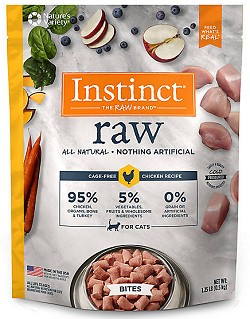 2) To buy a commercial raw food, visit your local pet store. You'll find frozen raw food in the freezer section; just defrost and serve. You'll find small bags of freeze-dried raw food on a shelf; just add water and serve. I use the frozen myself, but both are good.
2) To buy a commercial raw food, visit your local pet store. You'll find frozen raw food in the freezer section; just defrost and serve. You'll find small bags of freeze-dried raw food on a shelf; just add water and serve. I use the frozen myself, but both are good.
You can also buy these foods online.
See my recommended brands of frozen and freeze-dried dog food.
Commercial raw diets make complete meals by themselves, or when combined with my homemade recipe, or even with kibble or canned food.
To feed cooked food
 See my simple homemade recipe.
See my simple homemade recipe.
Do Dogs Prefer Raw or Cooked Meat? A Comprehensive Guide
Dogs are known for their love of meat, but does it matter if its raw or cooked? The debate over whether dogs prefer raw or cooked meat has been going on for years, with supporters on both sides. While there is no clear answer, there are benefits and risks associated with both types of meat that owners should consider when deciding what to feed their furry friends.
Raw meat is often seen as a more natural option for dogs, as it mimics what their ancestors in the wild would eat. Supporters of a raw diet argue that it is better for a dogs digestive system, as it is easier to digest and contains more nutrients than cooked meat. However, there are also risks associated with feeding dogs raw meat, such as the potential for bacterial infections or parasites.
Key Takeaways
- There are benefits and risks associated with both raw and cooked meat for dogs.
- Raw meat is often seen as more natural and easier to digest, but can also pose health risks.
- Cooked meat is a safer option, but may not contain as many nutrients as raw meat.
Raw Vs Cooked Meat
When it comes to feeding your furry friend, you may wonder whether to give them raw or cooked meat. Both have their advantages and disadvantages.
Raw meat is closer to what dogs would eat in the wild, and many dogs enjoy the taste. However, it can be risky due to the potential presence of harmful bacteria like salmonella and E. coli. Cooking meat can reduce the risk of bacterial infections, making it safer for your dog to eat.
Cooked meat is also more digestible than raw meat, which can be tough on your dogs digestive system. However, overcooking meat can reduce its nutritional value. Its best to cook meat to the point where its safe to eat but still retains its nutrients.
When it comes to specific types of meat, beef and lamb are safe to eat raw or cooked. Chicken, on the other hand, should always be cooked to avoid the risk of salmonella. Fish should also be cooked to avoid the risk of parasites.
Benefits and Risks of Raw Meat
Raw diets for dogs have become increasingly popular in recent years, with proponents claiming a host of health benefits. However, there are also risks associated with feeding dogs raw meat.
One of the most significant risks is the potential for bacterial contamination. Raw meat can carry harmful bacteria such as salmonella, listeria, and E. coli, which can cause serious illness in both dogs and humans. Additionally, raw meat can contain parasites, which can lead to a bacterial infection or E. coli poisoning.
Despite these risks, some advocates of raw diets argue that raw meat provides important health benefits for dogs. They claim that raw diets can improve digestion, promote healthier skin and coat, and boost energy levels.
However, there is little scientific evidence to support these claims. In fact, some studies have suggested that raw diets may actually be less digestible than cooked diets, and may not provide adequate nutrition for dogs.
Benefits and Risks of Cooked Meat
Cooking meat can provide several health benefits for your dog. When cooked correctly, it can kill harmful bacteria and parasites that can cause bacterial infections and illnesses such as e. coli poisoning.
However, cooking meat can also have its risks. Overcooking can deplete the nutrients and vitamins in the meat, making it less nutritious for your dog. Additionally, cooking meat at high temperatures can create harmful compounds that can increase the risk of cancer.
It is important to ensure that the meat is cooked to the correct temperature to eliminate the risk of bacterial infection. You should also avoid feeding your dog cooked bones as they can splinter and cause harm to your dogs digestive system.
Commercial Vs Homemade Dog Food
When deciding between commercial and homemade dog food, there are a few things to consider. Commercial dog food is convenient and can be found at supermarkets or online. It comes in different forms such as kibble, canned, or frozen. However, some commercial foods may contain processed ingredients that are not as healthy for your dog.
On the other hand, homemade diets can be tailored to fit your dogs specific needs. Homemade diets can include cooked or raw meat, vegetables, and grains. However, it can be time-consuming and requires careful planning to ensure your dog is getting all the necessary nutrients.
Nutritional Requirements and Digestive System of Dogs
Dogs have unique nutritional requirements that depend on their age, activity level, and overall health. The essential nutrients that dogs require include protein, fats, carbohydrates, vitamins, and minerals.
Protein is particularly important for dogs as it supports muscle growth and repair, and helps maintain a healthy immune system. Dogs require at least 18-25% protein in their diet. High-quality protein sources include meat, fish, eggs, and dairy products.
The digestive system of dogs is designed to digest animal-based proteins and fats, which means that they are better suited to a diet that includes meat. Dogs have a shorter digestive tract than humans, which means that they are less able to digest complex carbohydrates such as grains.
While dogs are capable of digesting cooked meat, raw meat is also a viable option as long as it is handled and prepared safely. Raw meat diets for dogs typically include muscle meat, organ meat, raw eggs, and bones.
It is important to note that dogs have different nutritional requirements depending on their age and activity level. Puppies require more protein and fat than adult dogs as they are still growing and developing. Senior dogs may require a diet that is lower in calories to maintain a healthy weight.
source
Veterinary Advice and Guidelines
When it comes to feeding your dog raw or cooked meat, its important to consult with a veterinarian or veterinary nutritionist. They can provide you with guidelines and advice on whats best for your dogs health and nutritional needs.
According to the Merck Veterinary Manual, raw meat can contain harmful bacteria that can cause illness in dogs and humans. Its important to handle and prepare raw meat properly to reduce the risk of contamination. Cooking meat to an internal temperature of at least 165F can help kill harmful bacteria.
Veterinarians generally recommend feeding dogs a balanced diet that includes a variety of protein sources, including cooked meat. Cooked meat can provide dogs with essential nutrients, such as protein, vitamins, and minerals.
Conclusion
In conclusion, whether to feed your dog raw or cooked meat is a personal preference. Its important to consider the nutritional value of the meat, as well as your dogs energy level and shiny coat.
While raw meat may be more expensive, it can be fresher and contain more nutrients. However, cooking meat can make it safer and more digestible for your dog.
Ultimately, the decision is yours. Consider what works best for your dog and your budget. And always make sure to use fresh ingredients and consult with your veterinarian before making any significant changes to your dogs diet.
Sources:
Frequently Asked Questions
How frequently should dogs consume raw meat?
Dogs can consume raw meat once or twice a week, but its essential to consult with a veterinarian before making any dietary changes.
Is raw meat superior to cooked meat for dogs?
Raw meat has some benefits, but it also carries risks. Cooking meat kills harmful bacteria and parasites that can make your dog sick.
Is cooked meat healthier for dogs than raw meat?
Cooked meat is safer and easier to digest for dogs. However, cooking can destroy some of the nutrients in the meat.
Can I buy raw meat from the supermarket to feed my dog?
Raw meat from the supermarket can contain harmful bacteria and parasites that can make your dog sick. Its best to buy raw meat from a trusted source.
Is raw meat beneficial for dogs?
Raw meat can provide some benefits, such as better digestion and healthier skin and coat. However, it also carries risks, such as bacterial infections. Consult with a veterinarian before feeding your dog raw meat.
My name is Ken and Im one of the staff writers at Petloverguy.com. Ive cared for pets most of my life starting with hamsters, turtles, and snakes. Then moving up to parakeets, guinea pigs, and even ducks.I currently live with two yorkies and a chihuahua mix.

